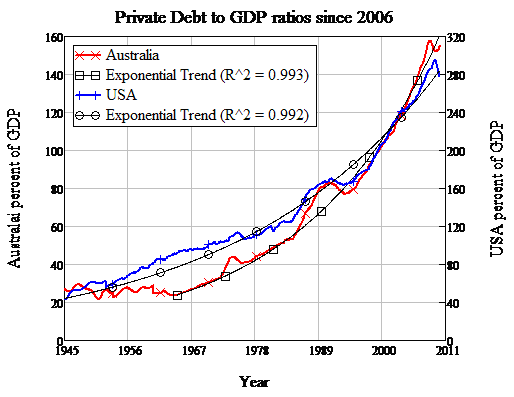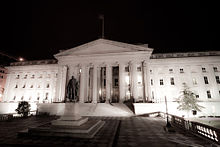_
{OMFG = Overt Monetary Financing of Government}
Introduction
Economies run on tokens from two balance sheet expansions:
- (The sum of) Banks’ balance sheet expansions, where bank loans create deposits (also called “horizontal” money)
- National, where the government spends into the economy expanding the national balance sheet (aka “vertical” money)
Two observations:
1) It is desirable, especially evident after 2008, to more carefully regulate the horizontal sector, which would also reduce its overall size significantly.
2) In the current economic climate it is desirable to expand the vertical balance sheet, both to maintain/increase aggregate demand and to foster activities that the public desires that increase the public’s well-being (infrastructure, education, healthcare etc.).
Note that although more carefully regulating the horizontal side would decrease aggregate demand (especially given the overheated credit impulse/acceleration Steve Keen has so usefully highlighted) this would be balanced by increasing the vertical side.
What do MMT economists and Positive Money propose regarding these two systems?
Both agree that the vertical side should be larger and the horizontal side more regulated with the resulting smaller horizontal component made up for by expanding the vertical side.
On The Vertical Side
The crucial fact about the vertical side is that the fact that a nation is not like a household is evident regardless of the operational details. Positive Money is wrong in their belief the current system must be changed to achieve the type of government spending they want.
However, this does not mean that Positive Money is flat out wrong. Key MMT people would be perfectly happy to spend vertically in the way Positive Money wants, which is just PQE/OMF by another name. This is especially so given that OMF procedures would be transparent and thus politically advantageous.
MMT scholars just do not believe it is remotely as urgent as Positive Money because they realize the current system is already capable of spending into the economy in the same way that PM wants to (Wray 2001, Fullwiler 2011 ). Also, many have rejected PM more or less out of hand because of Positive Money views or perceived views on the horizontal system [which we turn to below].
At any rate, regarding the vertical system – The crucial thing is to get the vertical system to do what is good for the economy – functional finance – regardless of the operational details.
From a political point of view it is better to have a clearer more straightforward system [PQE/OMF]. This is a substantially less fundamental problem, however, than what Positive Money thinks it is doing; in saying that, however, the practical and strategic importance of making the changes to a straightforward system perhaps should not be underestimated.
Scott Fullwiler himself has noted the fundamental agreement on vertical money issues:
“interestingly, understanding how DFM [Debt Free Money] works also illustrates the MMT view of government spending and government bond issuance. Logically we should expect that DFM supporters could join MMT in rejecting otherwise widespread concerns about government solvency, China refusing to purchase US national debt, the financial sustainability of entitlement programs, and so forth.” (Fullwiler 2014)
(relatedly and importantly, both Positive Money and many MMT economists propose ZIRP; another post for that though)
On The Horizontal Side
As noted, MMT rejects Positive Money mainly because of PM views on the horizontal side – in the past PM stated they wanted to eliminate the horizontal altogether and essentially create a loanable funds system. Contrast this to MMT, for which overall pre-2007 regulating the horizontal side was not a primary focus (not to ignore the Minsky-Wray connection and other pre 2007 work of course, but banking regulation was/is not the overarching focus of MMT). [Update: please see Scott Fullwiler’s comments on pre-2007 bank regulation/MMT)
However, both sides have moved closer together on horizontal money, to the point where in practice the horizontal systems they advocate would be similar.
MMT increased the emphasis on limiting the horizontal after 2007 (Mosler 2009, Mitchell 2009, Mitchell 2010, Wilson 2017). Crucially, the Mosler/Mitchell/Wilson proposals would be far more significant and profound in their effects than they are given credit for. Easily enforced common sense rules (that did not exist in 2008) to force banks to hold the loans they make, operate on a single balance sheet, and not accept financial collateral already clears up most of the problems with banking and would leave a drastically shrunk but drastically more healthy horizontal money and funding system in place.
Simply put, this puts MMT closer to the goals of PM on horizontal money than is generally recognized.
Conversely – Positive Money has moved to allow what is in effect horizontal money creation (whether “nationalized” or not makes little difference if regulated in the proposed ways). This pushes PM substantially towards the same horizontal system that would result were the Mosler/Mitchell/Wilson proposals to be put into practice.
(The similarity in views on this are evident in these quotes by MMT scholars and Positive Money:
“Right now, we have far more finance than we need. Exactly how much of it we could eliminate as unnecessary is up for debate. I wouldn’t be surprised if our economy would actually run better if finance was downsized by 90%”
L. Randall Wray 2014
“The correct approach, as highlighted by the MMT view, is to reduce bank lending by banning its use for anything that isn’t constructive. Bill Mitchell regularly suggests that 97% of financial transactions should be illegal.”
Neil Wilson 2014
“The central bank would be willing to create additional money, on demand, in response to banks that are able to lend that money to non-FIRE sector businesses. This protects the level of lending to businesses.”
Positive Money 2015)
Conclusion
There are two monetary systems, vertical and horizontal. Both MMT and Positive Money want to see the vertical increased in size to maintain aggregate demand and increase the general welfare; both MMT and Positive Money would like to see a more straightforward (PQE/OMF operations) vertical money system that would allow mainstream economists and the public to understand that a nation is not like a household (Positive Money makes the mistake of not realising that the current vertical system can already do what PM wants; MMT could perhaps make even clearer than they already do that the current system can do this without structural change).
Both MMT and Positive Money would like to shrink the horizontal system through reducing it to funding only real production. The two schools of thought come from utterly opposite directions on horizontal money; however in practice both of their suggested horizontal systems would be for all practical purposes the same – limiting banking to a completely safe payments system and to an investment-side that is regulated to only expand enough to fund productive investment but not to allow asset bubbles via a non productive FIRE sector. Whether the horizontal side is “nationalized” or not is merely a distraction – banks under the Mosler/Mitchell/Wilson rules providing for capital development based on solid credit analysis would operate the same regardless of their formal status vis-à-vis government. Positive Money is wrong to think this can be done in a loanable funds system (future post), but plain vanilla 1960s banking works fine.
~~~
March 28, 2019 UPDATE: The Intro to Economics textbook is finished! Live on Amazon here –
1000 Castaways: Fundamentals of Economics




